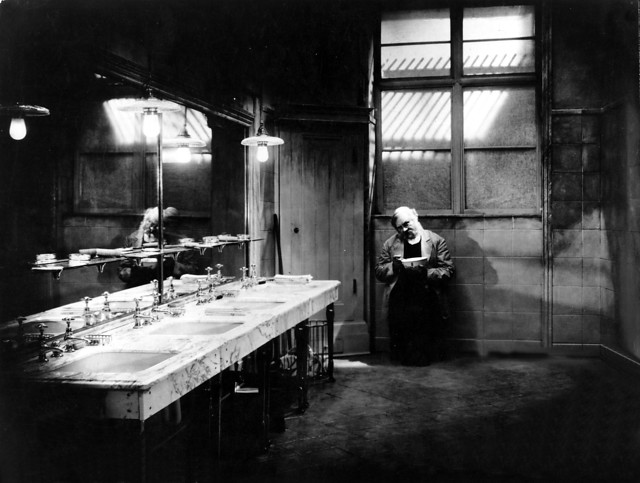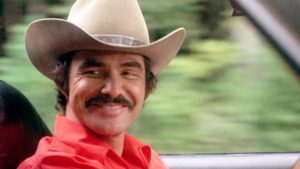originally published on Netflix’s Inside the Envelope
The silent era of cinema isn’t always the easiest sell to casual movie fans. There’s a nasty rumor that silent film equals boring film, and that’s just a notion born through a lack of exposure. Alfred Hitchcock called silent films the “purest form of cinema” and everything thereafter “pictures of people talking.”
I won’t discount, however, the perceived barrier to entry. There’s truth in the notion that viewing a silent film requires more active participation on the part of the viewer. Silents absolutely require your attention. They require you to put away your small screens (not a bad thing, you know) and devote 90-some minutes to flickering images. Once you submit yourself to the experience, you’ll be duly rewarded with a new understanding of the earliest building blocks of cinema and a fresh respect for film as a visual art form.
The 1920’s witnessed the final evolution of narrative film as a purely visual medium. Filmmakers such as Louis Feuillade, D.W. Griffith, Cecil B. DeMille and Ernst Lubitsch (among many, many others) had very nearly perfected the language of silent film. During these final ten years of the silent era, movies became increasingly more innovative and visually complex. In turn, audiences became more adept at reading signs and signifiers and translating these visual mechanisms into story.
I’m recommending the following 10 films as a guide for viewers looking to navigate or sample the final decade of cinema silence. I’ve picked one film from each year that highlights a particular artist or important film – and they’re all available for rent on physical media via Netflix DVD.
1920
The Mark of Zorro (dir. Fred Niblo)
Maybe you expected Robert Wiene’s The Cabinet of Dr. Caligari? While Caligari remains a landmark example of German Expressionism (distorted set design, dramatic use of light and shadow), we’ll touch upon some of these same elements in a couple years. If I pick Wiene’s well-known masterpiece, I wouldn’t have the opportunity to share with you Douglas Fairbanks’ wildly entertaining crowdpleaser, The Mark of Zorro.
Douglas Fairbanks proves himself as a deft comedian and daring stuntman. He required no trick effects to highlight his feats of derring-do. While trampolines aided some of his leaps and bounds, his pure athletic ability needed no embellishment. You’ll be doing handkerchief tricks and using the catch phrase “Have you seen this one?” in casual company. You’ll also clearly note the film’s DNA in every subsequent swashbuckler and a heap of jokes cryogenically frozen until Three Amigos thawed them out in 1986.
1921
The Phantom Carriage (dir. Victor Sjöström)
The last person to die during a calendar year assumes the job of driving the phantom carriage to gather the souls of everyone who passes during the following year. Makes for a spectacularly bizarre New Years Eve double feature with Trading Places (1983).
If for no other reason, you should watch Victor Sjöström’s macabre masterpiece for some of the most impressive special effects in all of silent cinema. This adaptation of a 1912 novel by Selma Lagerlöf (commissioned by the Swedish health association as a means of public education about tuberculosis) features stunning double exposures and an uncommon flashback structure. It’s a remarkable work of expressionist art –a scene where a spectral coach driver acquires a drowned soul by steering his carriage into the water still feels haunting and otherworldly.
1922
Nosferatu (F.W. Murnau)
No other cinematic vampire rivals the grotesque visage of Max Schreck. Coupled with Murnau’s expressionistic shadows and darkness, this is the adaptation of Stoker’s novel that best stirs the imagination with waking nightmares.
Drawing inspiration from Bram Stoker’s famous novel, Nosferatu dregs up some of our deepest fears about fate and mortality and allows them to play out in the story of Count Orlock (Shreck), a man with rat-like teeth and black-ringed eyes who preys on the living. The shocking inhumanity of the film’s main character must have horrified audiences in 1922 – because this masterpiece of horror remains unsettling in 2019.
1923
Safety Last! (Fred C. Newmeyer, Sam Taylor)
You’re probably familar with Buster Keaton and Charlie Chaplin (we’ll return to them forthwith) – but the holy triumvirate of silent-era comedians also consisted of a bespectacled “boy” named Harold Lloyd. Lloyd’s fourth feature-length film represents his crowning achievement in silent comedy. Safety Last! spins a yarn about a minor store clerk who organizes publicity stunt whereby his friend climbs the exterior of a tall building but finds himself performing the perilous stunt himself.
Whereas Buster Keaton conveyed droll emotion through his famous stone-face, the manic Lloyd allowed love and anxiety to flow from his pores. As a natural “everyman” Lloyd represented all of us – our struggles, hope and insecurities. He’s just a guy that wants to win the heart of a girl and prove himself successful in a hardscrabble world. Safety Last! gives us all of this, plus a legendary climax as Lloyd defies death hanging from a clockface in one of the niftiest bits of practical visual trickery committed to film.
1924
The Last Laugh (F.W. Murnau)
I hesitated to include another Murnau film along my tour of the 20’s, but The Last Laugh (aka Der letzte Mann) demanded attention because it documents the director’s broad talents and spotlights one of the purest actors of the era, Emil Jannings. Jannings inhabits a hotel porter, uncomfortably proud of his uniform and status, but increasingly unable to perform his duties due to his age.
Murnau immerses you in the porter’s spiraling decrepitude through flashy visuals almost entirely without intertitles. The Last Laugh contains roughly 15 minutes of narrative embellished by beautiful use of light and shadow, an affecting central performance and unprecedented camera techniques. Even if you’re not interested in the ways that Murnau invented cinema, The Last Laugh makes your soul ache in the best possible way.
1925
The Gold Rush (Charlie Chaplin)
Though Chaplin would later go on to eclipse the greatness of The Gold Rush with the even greater and similarly themed City Lights (1931) that should not diminish his earlier accomplishment. Drenched in pathos, The Gold Rush depicts a lone prospector heading to Alaska to find gold and improve his lot in life. Though riche prove elusive, he meets a woman and tries to win her heart.
Written, edited, directed and produced by Charlie Chaplin, The Gold Rush displays the filmmaker’s deft ability to blend slapstick with earnest melodrama. Many of the visual gags in The Gold Rush have become iconic (the dancing rolls, for example), but it’s the smaller moments, the moments in which Chaplin dwells on the minutiae of living and loving in unforgiving new territory that The Gold Rush becomes an essential silent film.
1926
The General (Clyde Bruckman, Buster Keaton)
Buster Keaton completes our holy trinity of silent-era comedians, and The General must be considered among his masterpieces. Set during the Civil War, Union spies steal engineer Johnny Gray’s beloved locomotive along with the love of his life, Annabelle Lee, still on board. Though Johnny had been denied enlistment because of his importance as an engineer, he single-handedly takes on the Union army to bring The General home and rescue Annabelle.
Though a flop upon its release, The General endures because of Keaton’s timeless sense of comedy and the film’s generous blend of pratfalls, romance and action spectacle. Keaton presented pure visual comedy accompanied by a sense of inimitable danger.
1927
Metropolis (Fritz Lang)
Class conflict, bloody generation gaps, fear of scientific progress, spirituality, and political demagoguery all play out in this expressionistic and highly formative dystopian nightmare by the great Fritz Lang.
Audiences greeted Metropolis with glazed-over eyes and disbelief. This is partly due to the fact that they viewed a version butchered by the studio, but also because Lang took massive strides forward as he experimented with the storytelling medium. Lang’s film remains a cornerstone of speculative science fiction; it just also happens to be a brilliant allegory. So much of this film still resonates that you’ll have a hard time believing it’s approaching 100 years young.
1928
The Man Who Laughs (Paul Leni)
Conrad Veidt might be best known for his role as Major Strasser in Casablanca (1942), but his greatest performances belonged to the silents in The Cabinet of Dr. Caligari (1920) and this Paul Leni-directed psychodrama about a corrupt king who carves a smile on the face of Gwynplaine, the son of his political opponent, and gives the mutilated child to the gypsies to live as a sideshow attraction. Gwynplaine falls in love with a blind girl and stumbles into a chance to regain his family’s position in society.
The Man Who Laughs possesses gothic horror qualities, drawing comparisons to Whale’s Frankenstein (1931), but plays out as a romantic melodrama as much as it does a horror film. Gwynplaine’s visage clearly inspired The Joker’s permanent grin, but the similarities remain purely cosmetic. Our frame of reference here might lead us to expect a film with less pathos and more mischief. All credit goes to Veidt who gives a timeless, emotive performance that transcends the limitations of the silent film medium.
1929
Diary of a Lost Girl (G.W. Pabst, 1929)
If you can only watch one G.W. Pabst/Louise Brooks collaboration, watch Pandora’s Box (which is not currently available on DVD Netflix). If you’re sticking to the curriculum by DVD Netflix, Diary of a Lost Girl comes in a close second.
A young girl, Thymiane, is raped by a clerk in her father’s pharmacy. The resulting pregnancy causes expulsion from her family and she is forced to fend for herself in a world that wants to use and abuse her. The oppressive bleakness of Pabst’s direction might turn away some viewers, but the shocking payoff makes the grind worthwhile.
At the time, critics claimed Louise Brooks didn’t act, that she was just a wooden screen presence. Brooks showcased a far more naturalistic acting ability and dared encroach upon performance realism. It wasn’t until many years later that the French film critics of the Cahier du cinéma rediscovered and reintroduced her to a more accepting world. Louise Brooks remains one of the most radiant silent-era screen presences. In any survey of the decade, she’s an essential figure – and an essential personality. Read her autobiography Lulu in Hollywood if you want to get a taste of the outspoken starlet and her legacy in a #MeToo world.


